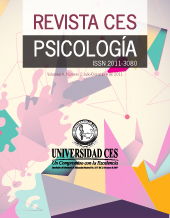Relapse Prevention Based on Mindfulness in the Treatment of Tobacco Dependence - Brazil
DOI:
https://doi.org/10.21615/cesp.13.2.9Keywords:
Smoking, Tobacco Dependence, Mindfulness, Depression, Anxiety, Carbon Monoxide, Addictive BehaviorAbstract
A randomized clinical trial was conducted to analyze the effects of a Mindfulness-based relapse prevention program for tobacco dependence treatment. The study was conducted at the Center for Psychosocial Care of Alcohol and Drugs (CAPSad), in the city of Porto Velho, capital of Rondônia, Brazil, 2017. 52 patients aged between 29 to 60, of both sexes, who were only tobacco users, participated in the research. To carry out this study, two groups were made up: G1 = experimental and G2 = control, both consisted of 26 people. In the pre-test, the data showed that there was no significant difference between these two groups. In the post-test comparison, there was a considerable difference in the reduction of anxiety symptoms (p = 0.043) and carbon monoxide-CO2 level (p = 0.03) in the lungs of smoking patients. In the result of the proportion analysis, there was a difference in G1 post-intervention with decreased symptoms of anxiety (p = <0.001), depression (p = 0.012) and carbon monoxide (p = <0.001), respectively. These findings showed significant effects of mindfulness in preventing relapse and reducing symptoms of anxiety, depression and carbon monoxide level the post-intervention group of smokers and dependent smokers treated at CAPSad.
Downloads
References
Associação Brasileira de Empresas de Pesquisa [ABEP]. (2017). Critério de classificação econômica Brasil. http://www.abep.org/criterio-brasil
Beck, J. S. (2013). Terapia Cognitivo Comportamental: Teoria e Prática. Porto Alegre: Artmed.
Beck, A. T., Ward, C. H., Mendelson, M., Mock, J., & Erbaugh, J. (1961). An inventory for measuring depression. Archives of General Psychiatry, 4, 561-571. doi: https://doi.org/10.1001/archpsyc.1961.01710120031004
Beck, A. T., Epstein, N., Brown, G., & Steer, R. A. (1988). An inventory for measuring clinical anxiety. Psychometric properties. Journal of Consulting and Clinical Psychology, 6(5), 893-897. doi: https://doi.org/10.1037/0022-006X.56.6.893
Beck, A. T., & Steer, R. A. (1993). Beck anxiety inventory (BAI) San Antonio: Phychological corporation.
Bowen, S., Chawla, N., & Marlatt, A. G. (2015). Prevenção de recaída baseada em mindfulness para comportamentos aditivos: Um guia para o clínico. Rio de Janeiro. Editora Cognitiva.
Carmo, J. T., & Pueyo, A. A. (2002). A adaptação do português do Fagerström test for nicotine dependence (FTND) para avaliar a dependência e tolerância à nicotina em fumantes brasileiros. Revista Brasileira de Medicina, 9(5),73-80. Recuperado de file:///C:/Users/UNIR/Downloads/A_adaptacao_ao_portugues_do_Fagerstrom_t.pdf
Cunha, J. A. (2001). Manual da versão em português das escalas Beck. São Paulo: Casa do Psicólogo.
Davis, J. M., Maggie, S. G., Anderson, C., Manley, A., Smith, S., & Baker, T. (2014). Randomized Trial on Mindfulness Training for Smokers Targeted to a Disadvantaged Population. Substace Use and Misuse, 49(5), 571-585. doi: http://10.3109 / 10826084.2013.770025
Diehl, A., Cordeiro, D. C., & Laranjeira, R. (2011). Dependência Química, Prevenção, Tratamento e Políticas Públicas. Porto Alegre: Artmed.
Fagerström, K. O., & Schneider, N. G. (1989). Measuring nicotine dependence: a review of the Fagerstrom Tolerance Questionnaire. Journal of Behavioral Medicine, 12(2), 159-82. doi: https://doi.org/10.1007/BF00846549
Germer, C. K., Siegel, R. D., & Fulton, P. R. (2016). Mindfulness e Psicoterapia. (2a. ed.). Porto Alegre: Artmed.
Gomes-Oliveira, M. H., Gorenstein, C., Lotufo Neto, F., Andrade, L. H., & Wang, Y. P. (2012). Validação da versão em português brasileiro do Beck Depression Inventory-II em uma amostra da comunidade. Revista Brasileira de Psiquiatria, 34(4), 389-394. doi: https://doi.org/10.1016/j.rbp.2012.03.005
Gorenstein, C., & Wang, Y. P.(2016). Inventário de Depressão de Beck (BDI). Instrumentos de Avaliação em Saúde Mental. Porto Alegre, Artmed.
Heppner, W. L., & Spears, C. A. (2016). Dispositional Mindfulness Predicts Enhanced Smoking Cessation and Smoking Lapse Recovery. Annalls of Beharioral Medicine, 50(45), 337–347. doi: https:// https://doi.org/10.1007/s12160-015-9759-3
Instituto Nacional do Câncer (INCA). (2017). In Programa Nacional de Controle do Tabagismo (PNCT). Recuperado de https://www.inca.gov.br/programa-nacional-de-controle-do-tabagismo
Marques, A. C. P. R. (2001). Consenso sobre o tratamento da dependência de nicotina. Revista Brasileira de Psiquiatria, 4(23), 200-214. doi: https://doi.org/10.1590/S1516-44462001000400007
Marlatt, A., & Donavan, D. M. (2009). Prevenção de Recaída: estratégias de manutenção no tratamento de comportamentos aditivos. Porto Alegre: Artmed.
Miller, W. R., & Rollnick, S. (2001). Entrevista Motivacional: preparando as pessoas para mudança de comportamento adictivos. Porto Alegre: Artmed.
Morón, D. A., Rey, R. A., & Martí, A. C. I. (2014). Mindfulness y ciência: de la tradición a la modernidade. Madrid: Alianza Editorial.
Mouzinho, L., Costa, N., Alves, T., Silva, S., L. (2018). Contribuições do mindfulness às condições médicas: uma revisão de literatura. Psicologia, Saúde & Doenças, 19 (2), 182-196. doi: http://dx.doi.org/10.15309/18psd190202
Nunes, S., & Castro, M.R.P (Org.). (2010). Tabagismo: abordagem, prevenção e tratamento. Londrina: Eduel.
Pietrobon, R. C., Barbisan, J. N., & Manfroi, W. C. (2002). Utilização do teste de dependência à nicotina de Fagerström como um instrumento de medida do grau de dependência. Jornal de Pneumologia, 28(4), 180-186. doi: https://doi.org/10.1590/S0102-35862002000400002
Prochaska, J. O., & Diclemente, C. C. (1982). Transtheorical therapy: Toward a more integrative modelo f change. Psychotherapy: Theory, Research, & Practice, 19(3), 276-288. doi: https:// https://doi.org/10.1037/h0088437
Rondinao, R. C., Gorayeb, R., & Botelho, C. (2007). Características psicológicas associadas ao comportamento de fumar tabaco. Jornal Brasileiro de Pneumologia, 5(33), 592-601. doi: https://doi.org/10.1590/S1806-37132007000500016
Reitsma, M. B., & Fullman, N. (2017). Smoking prevalence and attributable disease burden in 195 countries and territories, 1990–2015: a systematic analysis from the Global Burden of Disease Study 2015. Lancet, 389(10082), 1885–1906. doi: https// 10.1016 / S0140-6736 (17) 30819-X
Vinci, C., Spears, C. A., Peltier, M. R., & Copeland, A. L. (2016). Facets of Mindfulness Mediate the Relationship Between Depressive Symptoms and Smoking Behavior. Mindfulness. Rev.Scan, 5(7), 1408–1415. doi: https://doi.org/10.1007/s12671-016-0582-0
Weiss, I., & Noto, A. R. (2017). In Neufeld e Rangé. Terapia cognitivo comportamental em grupos: das evidências à prática. Porto Alegre: Artmed.
Wenzel, A., Brown, G. K., & Beck, A. T. (2010). Terapia cognitivo-comportamental para pacientes suicidas. Porto Alegre: Artmed.
World Health Organization (WHO). (2018). The top 10 causes of death. Recuperado em https://www.who.int/news-room/fact-sheets/detail/the-top-10-causes-of-death
Zeidan, F., Martucci, K. T., Kraft, R. A., Mchaffie, J. G., & Coghill R. C. (2014). Neural correlates of mindfulness meditation-related anxiety relief. Social Cognitive and Affective Neurosciense 9(7), 751-759. doi: https://doi.org/10.1093/scan/nst041
Downloads
Published
How to Cite
Issue
Section
License
Copyright (c) 2020 CES Psicología

This work is licensed under a Creative Commons Attribution-NonCommercial-ShareAlike 4.0 International License.
Each manuscript is accompanied by a statement specifyingThat the materials are unpublished, that have not been previously published in printed formatElectronic and that they will not be presented to any other means before knowing the decision of the magazine. ThroughoutIn case, any previous publication, sea in printed or electronic form, must be made known to the editorial staffWriting The authors attach a signed statement stating that, and the manuscript is acceptedFor publication, the rights of reproduction are the exclusive property of the Journal CES Psychology.| Article metrics | |
|---|---|
| Abstract views | |
| Galley vies | |
| PDF Views | |
| HTML views | |
| Other views | |




